You’ll identify synthetic opals by their unnaturally perfect, systematic color patterns and straight-line internal formations, while treated opals are natural stones enhanced through processes like sugar treatment or heat treatment. Synthetic opals feel lighter with plastic-like texture, whereas treated opals retain natural weight but may show dye marks or chemical residues. Natural black opals cost thousands, synthetics are noticeably cheaper, and treated opals fall between them in pricing. Understanding these distinctions will protect you from costly purchasing mistakes.
Understanding the Fundamental Differences Between Synthetic and Treated Opals
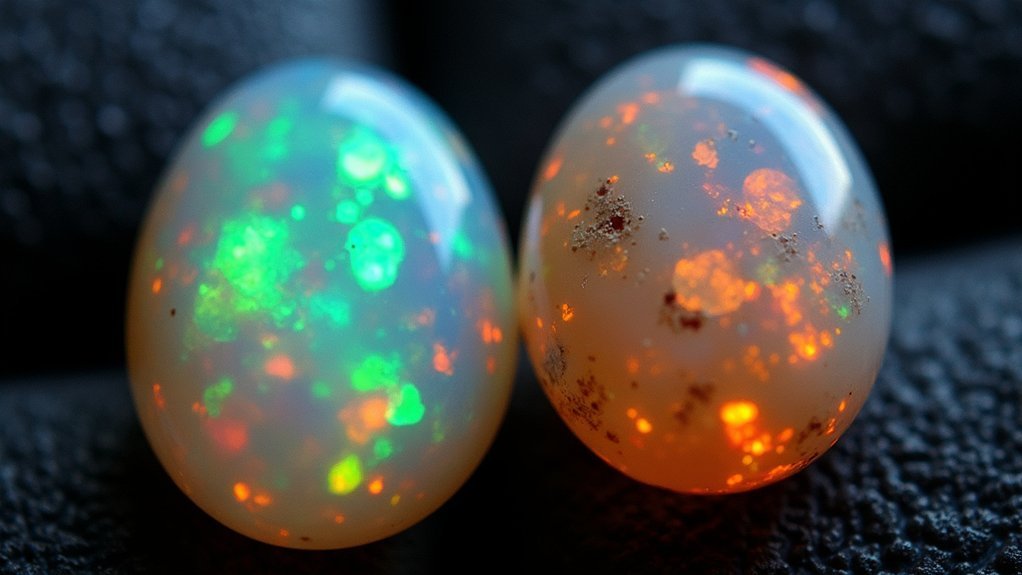
When you’re examining opals in the marketplace, you’ll encounter two distinct categories that often confuse collectors: synthetic opals created entirely in laboratories and treated opals that began as natural stones but underwent enhancement processes.
Synthetic opals like Gilson opal are manufactured using silica in controlled laboratory conditions. They display uniform patterns with overly perfect color play that appears systematic rather than random.
Laboratory-created synthetic opals exhibit unnaturally perfect, systematic color patterns that lack the random beauty found in genuine natural stones.
You’ll notice they often have a milky matrix and plastic-like feel when handled.
Treated opals start as genuine natural stones but receive enhancement through heat treatment, sugar treatment, or dyeing processes. While these stones retain their natural origin, they show chemical alteration signs like dye marks or smoke residue.
Understanding these fundamental differences helps you make informed purchasing decisions in today’s opal market.
Visual Characteristics That Distinguish Synthetic Opals From Natural Stones
You’ll notice synthetic opals often showcase unnaturally perfect patterns that lack the beautiful randomness found in genuine stones.
When you examine the internal structure, synthetic versions typically display straight-line formations while natural opals exhibit chaotic, varied compositions.
You can also distinguish them by feel – synthetic opals tend to be lighter with a plastic-like texture compared to the substantial weight of authentic stones.
Pattern Perfection Vs Randomness
Although both synthetic and natural opals can display stunning color play, their visual patterns reveal distinctly different characteristics that help gemologists and collectors distinguish between them.
When you examine a synthetic opal, you’ll notice unnaturally perfect patterns with systematic color arrangements. These manufactured stones often display the telltale “lizard skin” effect, where colors form structured, repetitive layouts that look too organized.
Natural opals showcase completely random patterns with chaotic color distributions that nature creates over millions of years.
You’ll observe irregular formations, varying brightness levels, and authentic imperfections that give each stone unique character. The randomness in natural opals creates depth and complexity that synthetic versions simply can’t replicate, making pattern analysis your most reliable identification method.
Structural Lines and Feel
Since synthetic opals are manufactured through controlled processes, they develop distinctive structural characteristics that you can identify through careful examination.
Look for straight line structures visible from the side view – these uniform patterns immediately signal a synthetic origin. Natural opals display irregular, random internal formations that can’t be replicated artificially.
Touch reveals significant differences between synthetic stones and the real deal.
Synthetic opals often feel lighter with a plastic-like texture, while genuine opals have a cooler, denser feel in your hand.
The surface of synthetic versions appears overly perfect and smooth, lacking the subtle imperfections and natural inclusions that give authentic opals their character and uniqueness.
Common Treatment Methods Used to Enhance Natural Opals
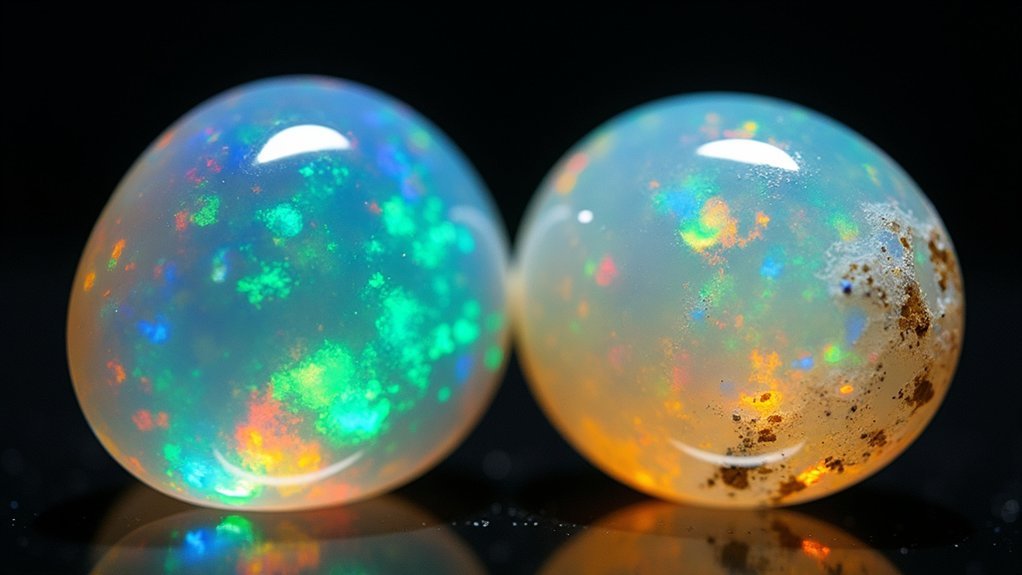
While natural opals possess inherent beauty, dealers often employ various enhancement methods to improve their appearance and marketability.
These treatment methods can greatly impact both value and authenticity, so you’ll need to recognize them when purchasing opals.
The most common enhancement techniques include:
- Heat treatment – Brightens colors but risks damaging the stone’s water content
- Sugar treatment – Involves soaking in sugar water then heating to carbonize and enhance vibrancy, particularly used for Andamooka opals
- Smoke treatment – Darkens appearance to mimic valuable Black Opals, requiring clear disclosure to prevent buyer deception
You can identify treated stones by examining the back for dye or smoke marks indicating tampering.
Understanding these treatments protects you from overpaying for enhanced stones marketed as completely natural opals.
The Sugar Treatment Process and Its Effects on Opal Appearance
You’ll find that sugar treatment involves a specific multi-step process that dramatically alters an opal’s visual characteristics.
The treatment soaks opals in sugar solution before heating them, which carbonizes the sugar within the stone’s porous structure and creates deeper, more vibrant colors.
You can identify these treated stones by looking for telltale signs like sulfuric acid residues and unnaturally enhanced color intensity.
Sugar Treatment Process Steps
Although sugar treatment might sound like something from a kitchen experiment, it’s actually a sophisticated enhancement process that transforms ordinary opals into stunning gemstones.
You’ll find this treatment particularly effective for lighter-colored stones from locations like Andamooka, where dealers create treated opals that rival expensive black opals.
The sugar water treatment follows these essential steps:
- Soaking Phase – Opals are immersed in concentrated sugar water solutions, allowing sugar molecules to penetrate the stone’s porous structure.
- Heating Process – Stones are heated to 200-300 degrees Celsius, causing the absorbed sugar to carbonize within the opal.
- Color Enhancement – The carbonized sugar creates darker background colors, dramatically increasing the stone’s color contrast and visual appeal.
This process notably enhances brightness and overall appearance.
Visual Changes After Treatment
When you examine a sugar-treated opal, you’ll immediately notice the dramatic transformation from its original appearance. The visual changes in treated opals are striking – colors become more vibrant and uniformly distributed throughout the stone. You’ll observe an artificial enhancement that lacks the natural variation typical of untreated specimens.
| Characteristic | Untreated Opal | Sugar-Treated Opal |
|---|---|---|
| Color Distribution | Variable, patchy | Uniform, consistent |
| Transparency | Natural clarity | Cherry red under yellow light |
| Color Intensity | Moderate variations | Enhanced vibrancy |
| Pattern Consistency | Irregular, natural | Artificially uniform |
| Dark Areas | Minimal | Unusual darkened zones |
Under yellow light, you’ll detect the telltale deep cherry red transparency that confirms treatment. Look for darkened areas and unnatural color patterns that distinguish these enhanced stones from their natural counterparts.
Identifying Sugar-Treated Opals
How can you distinguish between genuine and sugar-treated opals when examining potential purchases? You’ll need to look for specific visual indicators that reveal the treatment process.
Sugar-treated opals often display characteristics that differ greatly from their natural counterparts.
When evaluating treated opals, watch for these warning signs:
- Unusually intense jet black body color – This depth is extremely rare in untreated specimens.
- Abnormal color depth and transparency – The carbonization process creates unnatural visual effects.
- Enhanced vibrancy in lighter stones – Sugar treatment dramatically improves pale opals’ appearance.
GIA grading specifically identifies “sugared” specimens, particularly common in Andamooka opals.
You should exercise caution when encountering stones with these characteristics, as structural changes from treatment can compromise the opal’s long-term integrity and market value.
Heat Treatment Applications and Limitations in Opal Enhancement
Heat treatment serves as one of the most widely utilized enhancement methods for opals, offering significant benefits while presenting notable risks that you must carefully consider.
This process enhances color brightness and improves overall appearance, making stones more visually appealing than their untreated counterparts or even a synthetic version of natural opals.
However, heat treated specimens face structural integrity compromises due to opals’ water content and hydrophilic nature.
You’ll find that temperature sensitivity creates increased cracking and crazing risks, especially without careful application.
Andamooka opals frequently undergo this treatment to reveal richer colors and mask imperfections.
Unlike synthetic alternatives with overly perfect patterns, heat-treated natural opals retain unique characteristics while showing color enhancement signs.
Professional gemologists can identify these treatments through advanced testing, detecting internal structural changes and water content variations absent in untreated specimens.
Identifying Gilson and Chinese Synthetic Opal Varieties
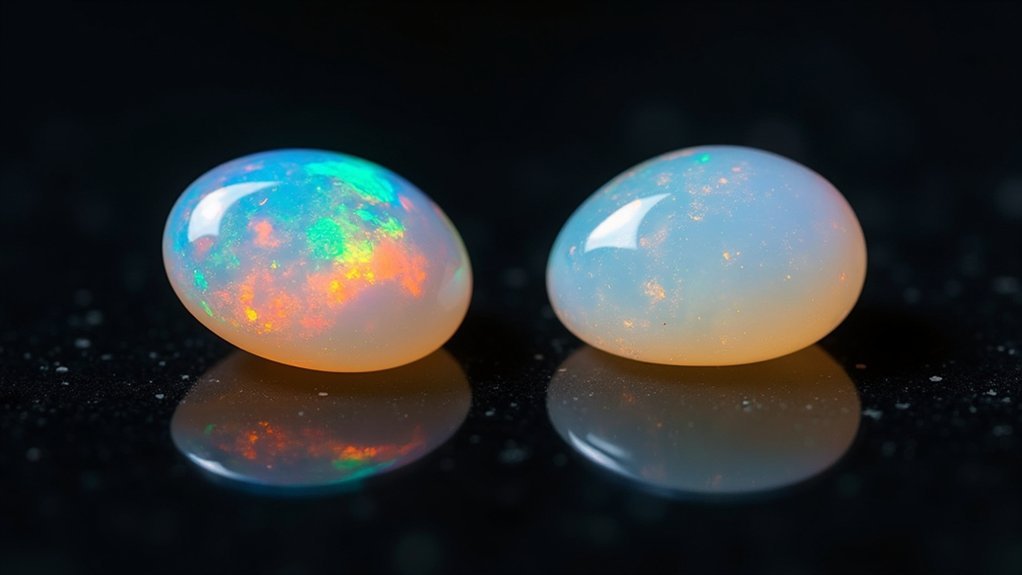
Since synthetic opal production began expanding in the 1970s, you’ll encounter two primary varieties that require distinct identification approaches: Gilson and Chinese synthetics.
Gilson opal, created from genuine silica since 1974, displays true synthetic characteristics with vibrant colors and uniform patterns. You’ll notice systematic color bands and smoother surfaces that distinguish these from natural stones.
Chinese synthetic opals differ markedly as they’re composed of resin mixtures rather than silica, creating a plastic-like feel and milky matrix appearance.
Key identification markers include:
- Pattern consistency – Both varieties show systematic, repetitive patterns unlike natural opals’ randomness.
- Surface texture – Gilson feels smoother while Chinese synthetics have a more artificial, plastic-like quality.
- Color distribution – Synthetic varieties display uniform color zones rather than natural irregularities.
Physical Properties That Reveal Synthetic Opal Construction
Beyond these visual identification techniques, synthetic opals reveal their artificial origins through distinct physical characteristics that you can detect through careful examination.
When you handle synthetic opal specimens, they’ll feel noticeably different from natural stones. You’ll notice a plastic-like texture rather than the cool, substantial weight of genuine silica-based opals.
The physical appearance of synthetic varieties often displays perfectly uniform surfaces without the natural inclusions or imperfections that characterize authentic stones.
Additionally, synthetic opals frequently exhibit what gemologists call the “lizard skin” effect—systematic color ordering that creates an unnaturally organized pattern.
When examining the stone’s profile, you’ll often observe straight-line structures that immediately signal artificial construction, contrasting sharply with natural opals’ irregular formations.
Side-by-Side Comparison of Natural, Treated, and Synthetic Specimens
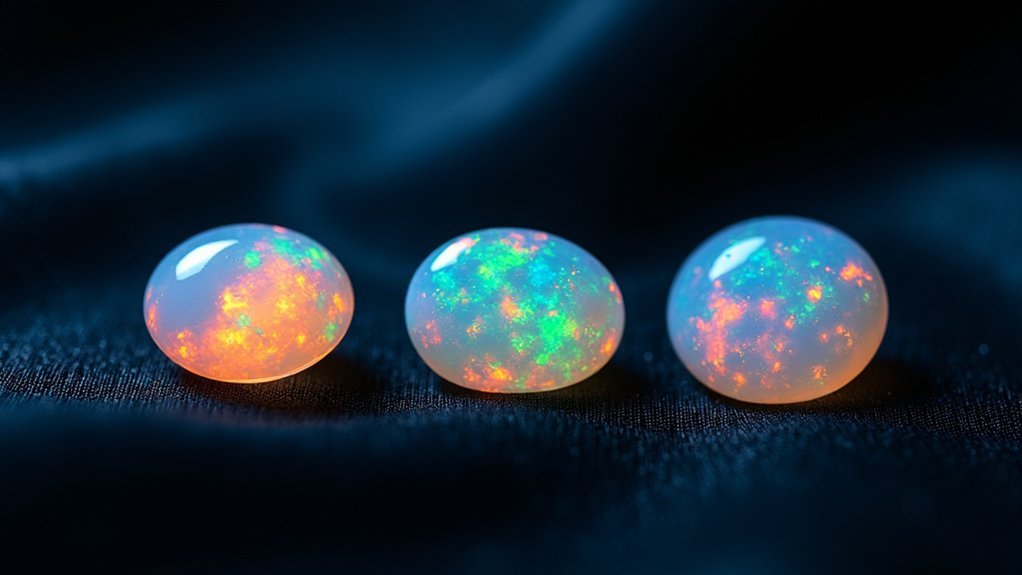
When you place natural, treated, and synthetic opals side by side, you’ll quickly notice distinct differences in their visual patterns and color distributions.
You can then apply simple physical property tests to confirm what your eyes are telling you about each specimen’s origin.
If you’re still uncertain after visual inspection and basic testing, professional authentication methods will provide the definitive identification you need.
Visual Pattern Recognition
Although distinguishing between natural, treated, and synthetic opals might seem challenging at first glance, you’ll discover that careful visual examination reveals telltale patterns that make identification straightforward.
When examining synthetic opal specimens, you’ll notice overly perfect, uniform color bands that appear too systematic. These artificial stones often display:
- Straight-line structures visible from side views, indicating manufactured composition
- “Lizard skin” patterns with repetitive, geometric arrangements of color
- Smooth, flawless surfaces lacking natural irregularities and inclusions
Treated opals reveal enhancement evidence through surface dye marks or smoke stains upon close inspection.
Natural specimens exhibit chaotic, organic color play with random patterns that can’t be replicated artificially. The key lies in recognizing whether patterns appear naturally formed or mechanically created through human intervention.
Physical Property Tests
Visual examination provides your first clues, but physical property testing offers definitive proof when comparing natural, treated, and synthetic opal specimens side by side. You’ll discover distinct characteristics that reveal each type’s true nature through systematic testing.
| Test Method | Natural Opals | Treated Opals | Synthetic Opals |
|---|---|---|---|
| Water Absorption | Absorbs water, enhances color | May absorb differently due to treatments | Won’t absorb or change appearance |
| Side View Structure | Irregular, varied internal patterns | Natural base with treatment evidence | Straight line columnar structure |
| Back Surface | Natural inclusions and imperfections | Dye marks, smoke stains visible | Uniform, artificial appearance |
| Play of Color | Random, unique patterns | Modified natural patterns | Overly perfect, uniform displays |
| Professional Tools | Confirms authenticity | Reveals hidden treatments | Identifies synthetic markers |
These tests help you distinguish synthetic opals and treated opals from natural specimens accurately.
Professional Authentication Methods
Since professional authentication requires specialized equipment and expertise, certified gemologists rely on advanced instruments like refractometers, spectrometers, and high-powered microscopes to reveal definitive differences between natural, treated, and synthetic opals.
These professional authentication methods provide conclusive identification through precise measurements of optical properties and chemical compositions.
You’ll benefit from understanding what experts examine during authentication:
- Structural analysis – Natural opals show irregular formations, while synthetic opals display uniform textures and straight-line patterns.
- Water absorption testing – Genuine stones enhance color when absorbing water, unlike treated specimens that repel moisture.
- Chemical composition mapping – Spectrometers detect artificial enhancements and dye treatments invisible to naked eyes.
Certified laboratory reports offer definitive authentication, providing detailed documentation of origin, treatments, and authenticity for complete purchase confidence.
Professional Testing Methods for Opal Authentication
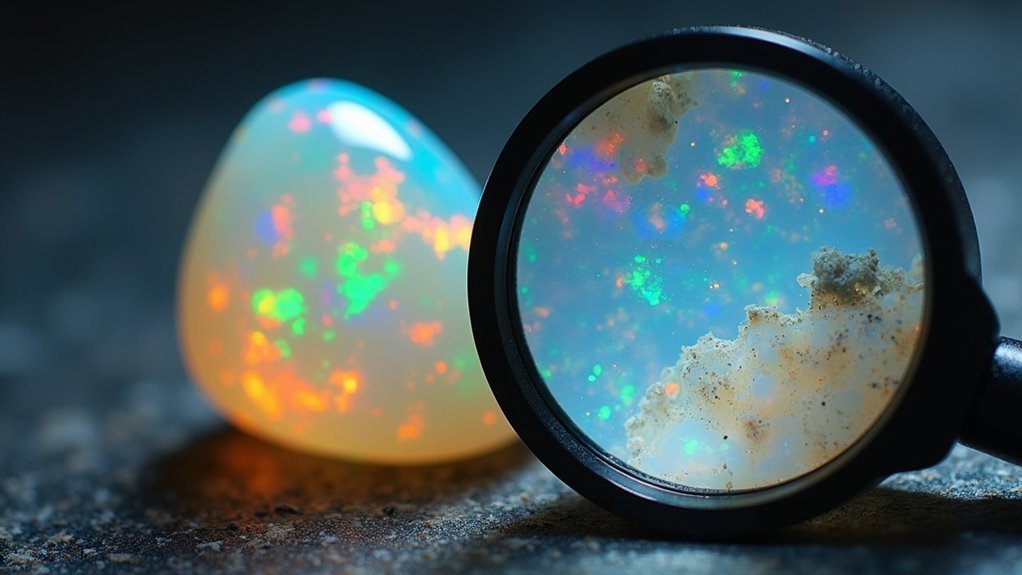
When you’re uncertain about an opal’s authenticity, professional gemologists employ sophisticated testing methods that go far beyond basic visual inspection. These professional testing methods utilize advanced equipment to definitively identify synthetic opals and treated stones.
| Testing Method | Purpose | What It Reveals |
|---|---|---|
| Refractometry & Spectroscopy | Analyze optical properties | Light interaction patterns unique to natural vs synthetic stones |
| X-ray Diffraction | Examine crystal structure | Consistent patterns in synthetic opals like Gilson varieties |
| Infrared Spectroscopy | Detect chemical compounds | Presence of sugar, dye, or other treatment substances |
Microscopic examination reveals natural imperfections that synthetic opals typically lack. Professional certification from accredited laboratories provides thorough testing reports, validating authenticity and treatment status for complete buyer confidence.
Market Implications and Pricing Differences Between Opal Types
Understanding the market value of opals requires recognizing how dramatically prices vary between natural, treated, and synthetic varieties.
You’ll find natural black opals commanding thousands of dollars, while synthetic opal alternatives cost a fraction of that amount. Treated opals fall somewhere between, depending on disclosure practices.
The market faces significant challenges due to transparency issues:
Transparency challenges plague the opal market, creating confusion and unfair pricing that undermines consumer confidence in authentic stones.
- Misleading marketing – Vendors often don’t clearly distinguish between natural, synthetic opal, and treated opals
- Price manipulation – Undisclosed treatments can inflate treated opals’ values unfairly
- Consumer confusion – Buyers struggle to make informed decisions without proper certification
You’re increasingly seeking authenticated stones as synthetic varieties become more prevalent.
This demand for transparency drives the importance of professional certification and clear labeling practices to maintain fair pricing structures.
Certification Requirements and Disclosure Standards for Opal Sales
How can you protect yourself from purchasing misrepresented opals in today’s complex marketplace? You’ll need proper certification of origin and authenticity documentation that reveals any treatments your stones have undergone.
Reputable sellers must disclose treatments like dyeing, smoking, or sugar enhancement to maintain consumer trust. When you’re shopping, verify smoked opals aren’t misrepresented as natural black opals. Ethiopian opals require certification to be classified as black opals, preventing quality confusion.
You should demand transparency in descriptions and verify adherence to certification standards before making purchases. This documentation helps you understand your opal’s true value and make informed decisions.
Without proper disclosure, you can’t accurately assess what you’re buying or determine fair pricing.
Frequently Asked Questions
How to Tell if Opal Is Real or Synthetic?
Check the opal’s color patterns for randomness versus uniformity. Feel its weight and temperature – real opals are heavier and cooler. Look for natural inclusions and irregular edges, then test water absorption.
How to Tell if Opal Has Been Treated?
Check the opal’s back for dye or smoke marks indicating treatment. Look for overly uniform black coloring and inspect under bright light for unusual transparency or color inconsistencies that suggest enhancement.
Do Fake Opals Glow Under a Blacklight?
You’ll often see fake opals glow under blacklight, especially resin or glass ones. They’ll show uniform fluorescence that natural opals don’t typically display, making blacklight testing helpful for spotting fakes.
How to Tell the Difference Between Natural and Lab Grown Opal?
You’ll notice natural opals have irregular, random color patterns while lab-grown ones show uniform bands. Natural opals feel heavier, cooler, and contain inclusions, whereas synthetic versions appear too perfect.
In Summary
You’ll need to carefully examine opals before purchasing, as synthetic and treated stones can greatly impact value. Don’t rely solely on visual inspection—professional gemological testing remains essential for accurate identification. You’re responsible for understanding disclosure requirements and asking sellers direct questions about treatments or synthetic origins. When you’re investing in opals, proper certification protects your purchase and guarantees you’re getting exactly what you’re paying for in today’s complex marketplace.

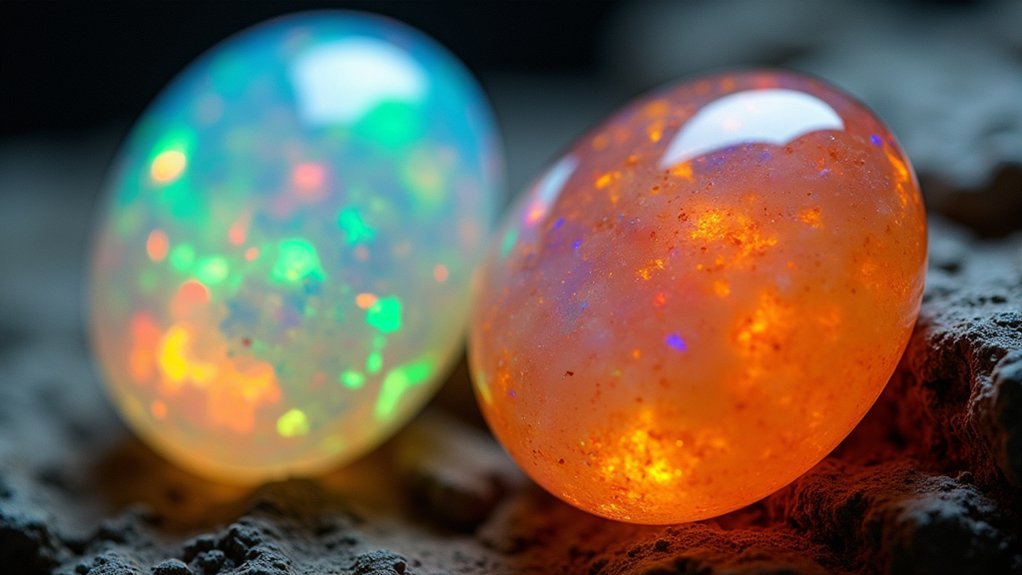
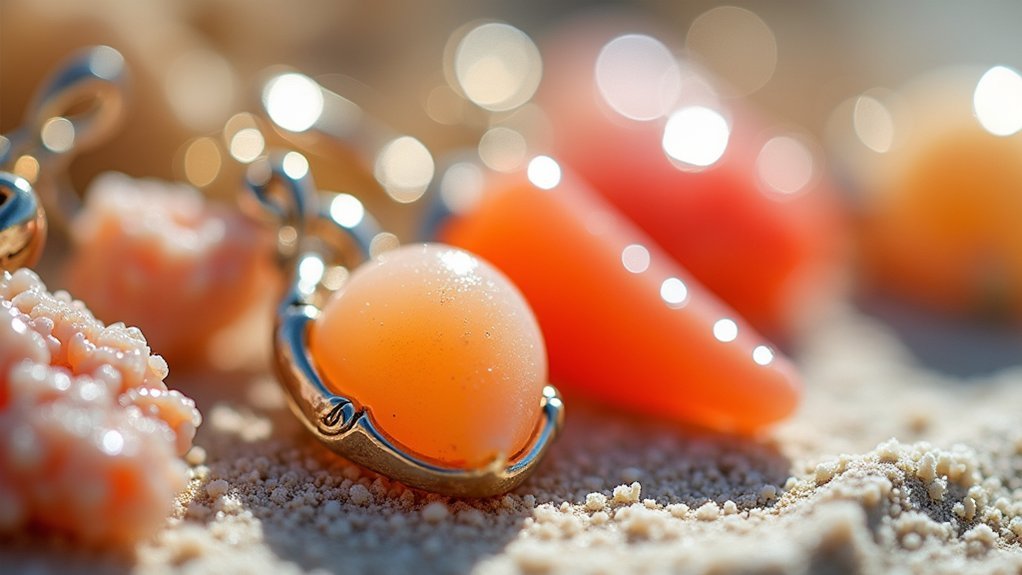

Leave a Reply